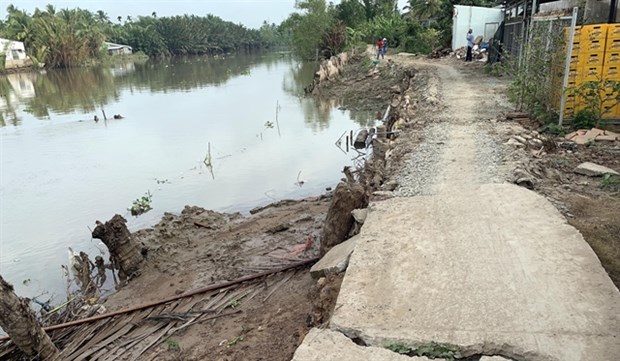Mekong Delta faces increasing erosion
The Cuu Long (Mekong) Delta is experiencing increasing erosion, but local authorities are taking steps to mitigate the damage to agriculture and thus to people's lives.
 An eroded river bank that has affected a rural road in Soc Trang province’s Ke Sach district has been repaired to restore transport. (Photo: VNA)
An eroded river bank that has affected a rural road in Soc Trang province’s Ke Sach district has been repaired to restore transport. (Photo: VNA)In the upstream area of the Tien River, a tributary of the Mekong, in Tien Giang province, erosion has occurred at many places along the Tra Lot and Rach Ruong rivers and 28 and Nguyen Van Tiep canals in Cai Be district.
In early March, a 50m section was completely eroded on the Tra Lot river’s eastern bank, blocking a road in Hoa Khanh commune.
Vo Van Dan, an official in Hoa Qui hamlet, said erosion is severe in four spots and extends a total length of 300 metres.
It has damaged farmlands, transport infrastructure and power lines and affected people’s lives and agriculture, he said.
It also poses a threat to people’s safety, especially when low-lying areas are inundated during high tide, he said.
Cai Be has suffered a total of 2.1km of erosion in 62 places, and requires more than 27.7 billion VND (1.2 million USD) for repairs, according to its Division of Agriculture and Rural Development.
In Can Tho city, there have been two cases of erosion this year.
One was along the O Mon River in Thoi Lai district where a section of land 26 metres in length and 12 metres in width was washed away, causing losses of 800 million VND (34,100 USD).
The other, 25 metres in length and three metres in width, was along the Thanh Dong canal in Cai Rang district’s Phu Thu ward.
In Tra Vinh province, the People’s Committee declared an erosion emergency on Nhan riverine island in Duyen Hai district last month.
Tran Truong Giang, Director of the provincial Department of Agriculture and Rural Development, said the island has lost 220ha of land since 2015.
High tides and waves have caused erosion, inundated 11 houses and damaged 6.5ha of vegetables in recent months, he said.
Erosion is threatening the safety of 166 households with nearly 500 people on the island, and 56 of the households need to be relocated immediately, he said.
In Ben Tre province, there are 112 erosion spots along rivers, canals and coastal areas with 138km affected, according to its Department of Agriculture and Rural Development.
The province loses 120ha of land and 100ha protective forests along coastal areas to erosion each year.
The worst cases are in Binh Dai, Cho Lach and Mo Cay Nam districts.
Erosion in the delta is caused by natural as well as human factors such as sand mining and illegal construction of houses and other structure along the banks of rivers and canals, according to experts.
Solving problem
To mitigate the increasing erosion, authorities in the delta, which comprises Can Tho city and 12 provinces, are taking measures like building embankments.
Nguyen Van Vinh, Chairman of the Tien Giang Provincial People’s Committee, said five erosion prevention projects are being built at a cost of 305 billion VND (13 million USD) to prevent erosion along a total length of 3.1km in 2022-2023.
The province has asked the Government for funds for more erosion prevention projects in Cai Be, Cai Lay and Cho Gao districts and My Tho city.
Last month, Ben Tre started building a 20.7km embankment in Tam Hiep riverine island in Binh Dai district.
It will cost 325.6 billion VND (13.9 million USD) and protect 700ha of farmlands and 3,271 people when completed next year.
Besides building preventive works, the delta’s coastal provinces like Soc Trang, Ben Tre and Tra Vinh provinces have also focused on growing mangrove forests to check erosion.
Ben Tre plans to grow 171ha of new forests, mostly mangrove, this year, and Tra Vinh targets planting 800ha of mangrove in 2021-2025.
Tra Vinh has decided to build a resettlement area to relocate 75 households in an eroded area in Tra Cu district’s Dinh An commune.
It will cost 22 billion VND (940,000 USD) and is expected to be finished this year./.













